Aquaponics: Back Yard Fish and Farm Ponds
Fish that can be easily grown in the back yard:
Topics:
Use a low speed, low wind, windmill to pump
the water
Aeration: One low tech solution is a constant flow of water, from elevated
storage tank or solar panels, down into the pond. I can add a small splash
shield to keep spray off the insulative cover or just to keep it in the pond.
The thing is, even if power, etc... fails, that water will keep going for
as long as the roof mounted storage tank lasts. I'll probably add some standard
air pump type aerators as well, but he water fall will A) look nice and B)
provide very reliable O2 and C) the bubbles comming back up can be used to
rotate a bio-wheel.
AgPals says "Microbes prefer 7.5ph. Plant happy medium at 6.5. Set pH at
7 for max compromise"
Avocado in hydroponics: 3' container, drain, gravel in bottom, sand on top,
drip. Lower roots are structure and holding, upper roots are feeder. Keep
lower dry, upper wet.
Also:
See also:
-
-
http://www.tilapiaforsale.com Another source for several
varieties of tilapia fry and fingerlings. Lots of great info
also.
-
http://premiumfishfood.com Here's a good site for buying
bulk tilapia fish food. They have fry powder, crumble and pellets. Excellent
pricing.
-
http://www.tilapiasource.com You can get tilapia that are
a bit more cold tolerant from White Brook Tilapia Farm. They grow faster
than blue and mozambiques too.
-
-
-
http://www.healthyplanetharvest.com/
Medium small aquaponics systems for a few hundred dollars. Local to North
County San Diego. (Escondido, Vista)
-
http://www.mybackyardfishfarm.com
Very small aquaponics systems for $149 and up. Basically a food grade 55
gallon drum, air pump, biofilter, and some fingerlings. She also sells
fingerlings for $1 each.
-
http://www.backyardaquaponics.com
-
http://www.mbayaq.org/cr/seafoodwatch.asp
Monterey Bay Aquarium has a very complete index of fish and the relative
safety or danger of eating them based on source, etc...
-
http://www.rhizomecollective.org/virtual_tour.htm ... It
is an experiment combining edible water plants (rice, water celery, lotus)
with green manure plants (water hyacinth, azolla), ornamental plants and
animal life. The animal life includes minnows, crawfish, frogs, dragonflies
and snails. The gambusia minnows and the dragonfly larvae help enormously
in reducing the mosquito population. The pond creates beauty and attracts
wildlife as well.
An additional part of the pond system are the chinampa gardens. Chinampas
were a form of agriculture used by ancient Aztecs, where water plants and
weeds would be piled onto the banks of waterways. Vegetables are planted
directly into them, thus creating a highly fertile growing medium with a
nearby water table. ...
-
http://www.motherearthnews.com/menarch/archive/issues/031/031-076-01.htm
REPORT ON AN EXPERIMENTAL SOLAR-HEATED
AQUACULTURE SYSTEM
-
http://overton.tamu.edu/htmsub/tilapia.html
Raising Tropical Food Fish
in Small Greenhouses Promises Profit for Texans (a total cycle, plant
seedlings are grown in water cleaned by the Tilapia)
-
http://www.youtube.com/user/Noz7777#p/a/f/2/CU9x_W9X-tM
video of a very nice, high tech, auquaponics setup.
-
http://www.aquaponics.com/articlegreenwater.htm
In the greenwater system some nutrients are recycled back to the fish. The
vertical-lift pump and air stones keep detritus, feces and plankton in constant
circulation. Nitrifying bacteria (Nitrosomonas and Nitrobacter spp.) colonize
this floating "substrate" creating a "suspended growth treatment process".
These bacteria oxidize toxic total ammonia nitrogen (TAN) into relatively
harmless nitrate (NO3-) and heterotrophic bacteria (bacteria that consume
organic matter) proliferate. The suspended growth treatment process maintains
adequate water quality for the fish while recycling waste nutrients into
plankton and bacteria. Tilapia graze on these and receive supplemental nutrition,
thus lowering feed conversion ratios and feed costs. An added advantage of
this process is the elimination of the need for a fixed-film biofilter, which
would not only increase capital costs but also increase management and
maintenance needs.
[The water is circulated through a clarifier once each 24 hours.] As the
water moves under the baffles within the clarifier, its flow becomes laminar,
enabling detritus, feces and dead algal and bacterial cells to settle to
the bottom. Twice daily this sludge is drained from the clarifier and used
as plant fertalizer reducing the biochemical oxygen demand (BOD) of the culture
water and encouraging continued algae and bacterial population growth, which
further improves water quality.
Caution: In the event of [an airation failure], all of the fish in the system
would asphyxiate within hours. This is because the suspended growth treatment
process creates a very high BOD. Overfed algae grow wildly. When they die
and decay, [the bacteria which consume them] use oxygen.
-
Cichlids
Newsgroup: rec.aquaria.freshwater.cichlids
-
http://members.aol.com/frugally4u/pond.html I Built my
Own Beautiful Garden Pond for Under $4 and You Can Too! Only if you can
find "Silo Cap" or someone donates a liner.
-
http://journeytoforever.org/farm_pond.html
Aquaculture for small farms
"...for a liner, I learned
of a product called a 'silo cap.' Found at any farm store..." Yeah right.
I'll be damned if I can find it.
Possible sources of liners:
Search:
See also:
James
Newton Says:
The fish pond is starting to take shape. I found a
graded lot near work were I can steal rocks pretty safely, and I hit uppon
the idea of driving wood stakes (firewood) into the ground between my bolders
to help support the smaller rocks. Then I've backed up the rocks with sod
cut from the area inside the pond so that the inner wall looks sort of like
a vertical lawn at the moment. Its sort of like adobe (I hope) and seems
to be holding so far.


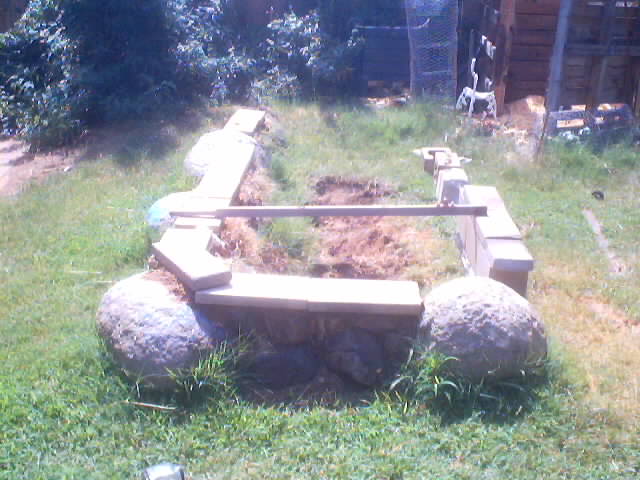
Finally filled it this last Saturday: 2004/07/10. Many thanks to Erich Wolfe
and Jeff Mullens (?) for helping to spread, fill and finish the liner. Sadly,
I couldn't find batteries for the power sucker I call a digital camera until
after we had spread and started to fill the liner, so it is a bit hard to
see what the inside looked like before we laid it out. There is a nice layer
of scrap cardboard and soft play sand under it. All rocks, sticks, shards
or anthing else that might puncture the liner has been removed.
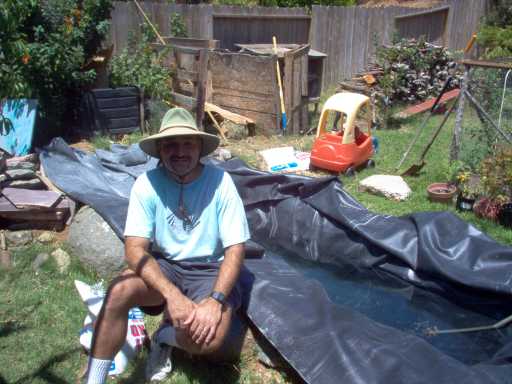
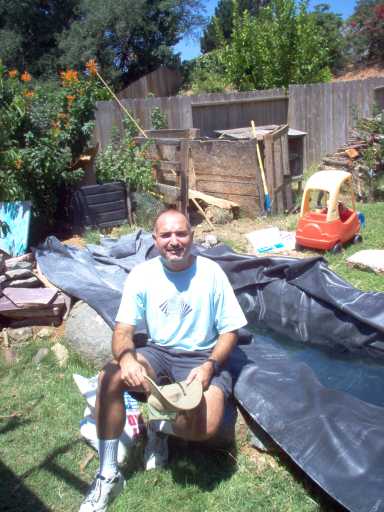
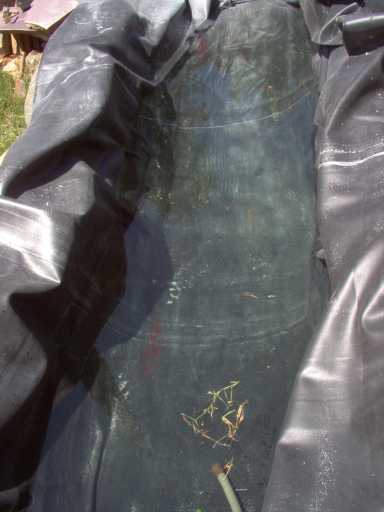
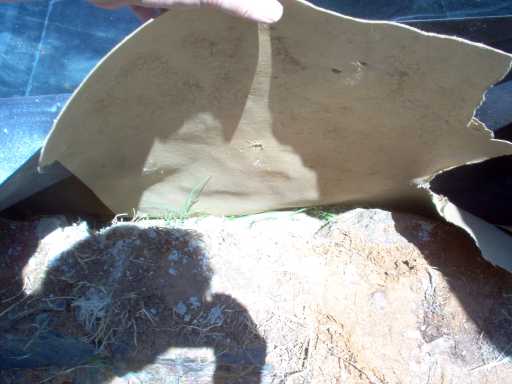

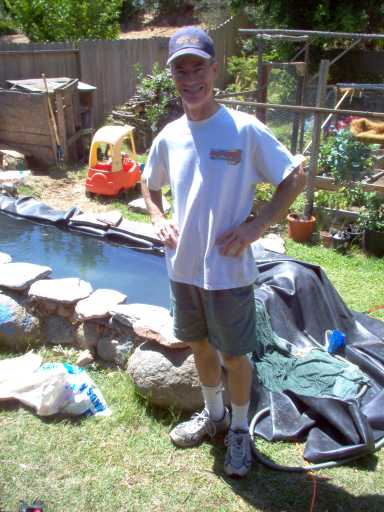
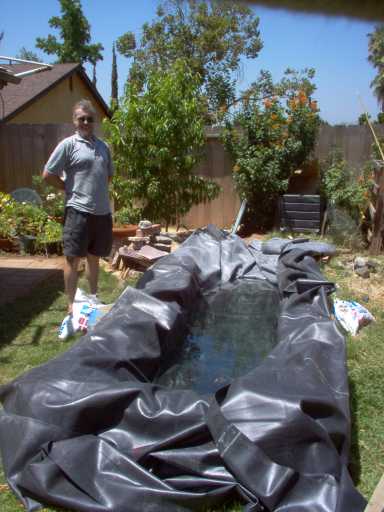
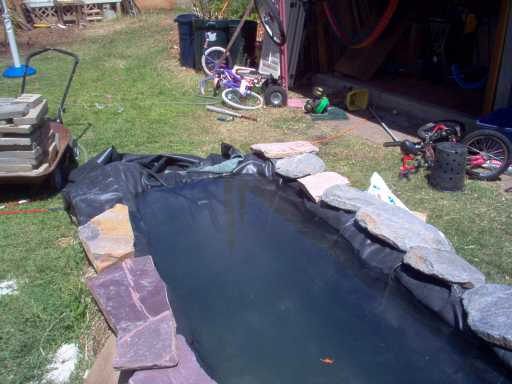
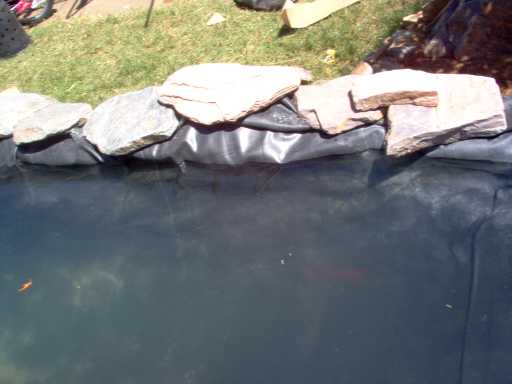
Still need to:
-
Figure out how to hid that last bit of liner
-
Add more rock around the lip (Recieved some free slate from a nice family
via the sdfreecycle so that might help)
-
Plant some water plants and get mosquitoe control fish in place.
-
Get the kids to pick up the back yard and STOP SPLASHING ABOUT IN MY POND!
James
Newton replies: One week later, mosquitoe larve started to show up
so I got some of the mosquitoe eaters from the
San Diego
County Dept. of Environmental Health and they seem to be doing fine.
We thought they had been eaten by the next day, but it turns out they are
just REALLY good at hiding.
Starting to get the first "blooms" of algea so the water gets cloudy then
clears up, then does it again.
Also got some floating plants from the
San Diego Water Garden
meeting. A VERY kind and giving host opened his home (and life) to more
questions (from my 7 year old), pokes, proding and soda spilling than he
probably wanted. THANK YOU!
James
Newton replies: Erich Wolf sent on some floating plants and a few
more fish. All the plants seem to be getting a bit much sun, but are holding
their own. The fish are breeding, eating, and loving life.
Debra, a nice local bunny lady, donated a stone sink which I will setup as
a cistern for the "poopy" water siphoned from the lowest point in the pond.
I have to find a way to seal it since it does leak a bit.
James
Newton Says:
The plants don't seem to have done all that well...
the heat followed by cold snaps this winter have all but done them in. The
mosquitoe eaters have done well, but spend most of thier time quiet and deep
when the temperature drops. The bottom of the pond is at 42' and steady while
to top varies from 44 to 65 with the air temperature from 50 to 80.
Some form of insulation (perhaps a good plant layer?
or floating bubblewrap?) is going to be required along with heating if there
is any hope of growing talapia.
A local "going out of business" sale at a place that
does water filters yealded two pumps for $25 each and I "dummied" up a bamboo
flue from the roof of the porch out over the pond. The resulting drop is
about 6 feet and provides more than enough aeration with only a very little
"splatter" so I don't think water loss will be a problem. The pump draws
75 watts so that is no more than a standard lightbulb. I'd rather use wind
power, but the pump will be an acceptable alternative and a good backup when
the air is still at night.
Questions:
-
how about running
a coil of pipe underneath a hot compost pile to heat the water?
-
ianrosebrook@netzero.com
asks: " I wish to but a few pairs of talapia
fish to raise. Any one have some to sell to me?"
-
jnorth262@yahoo.com
asks: " Hello!
What is the smallest size pond that I can use to grow happy tilapia in houston,
tx?"
-
markshana@bellsouth.net
asks: " Is there a way to catch talapia on
rod and reel?"
James
Newton Says:
The summer of 2005 has passed with the plants doing
a bit better than last summer since the lovely peach tree we planted between
the pond and the west fence is providing a bit of shade. We added two lilly
plants which have been blooming very nicely. We did have some aphids on the
pads, but I just push the pads under watter and the fish go nuts clearing
the bugs off.
I've finalized the bamboo flue with about a 3 foot
drop and that seems to do well for both aerating and circulating the water
through the cistern. The algea grows nicely in the bottom half of the cistern
and accumulates the "fish poop" and so on under it. I pull the algea to the
side and scoop out the "black water" from time to time for the garden and
fruit trees. I plan to add some media for the algea to grow into inorder
to clean the water a little more.
The pump and siphon have been unreliable. Somehow,
air always seems to get into the tubing or algea clogs it. I put a loop in
the hose on the outlet of the pump and ran it up the side of the fence and
back down to the flume. Then I added a cheap timer to turn the pump on and
off every half hour. When the pump turns off, the water rushes back down
the outlet hose, through the pump, and flushes out the inlet removing debris
and air. This has improved the system, but it still requires flushing out
every few weeks.
I've added a small air pump and stone bubbler to increase
the aeration and fill in for possible failures of the pump / flume during
the summer when the water is warm and O2 levels are likely to be critically
low. So far, the mosquitoe eaters and the goldfish are doing fine, getting
fat.
Another problem is that although the sloping sides of the pond do a great
job of collecting gunk in the center, the plants also grow out of the center
so scraping out the gunk kills all the plants. A better design would be a
series of steps doing down so that the plants don't all slide to the center
and some can be kept in pots below the surface. I think the gunk would still
make it to the center bottom and then could be scraped out, killing only
the plants that rooted in that deepest water.
Talapia next spring!
James
Newton Says:
Spring of 2006 brings a pair of blue talapia to the
little pond. They are hard to see, but have been spotted on one or two occasions
throught the summer. They are not large, perhaps 2 inches long, and we do
not expect to fill our tummies with them any time soon. As fall approaches,
my biggest concern is how to winter them. I don't want to waste electricity
heating the pond so I am looking into providing some sort of solar hot water
heating. Perhaps coiling the pump outlet hose on a black surface in the sun.
The problem there is finding any sun in the area around the pond. I also
have two large solar water heating panels, but installing them will be quite
a bit of work and again, finding a place is a challenge. If you start on
a pond, think more about the path of the sun than I did.
James
Newton Says:
The talapia died as soon as the temperature dropped
out of the 80's. I'm adding a solar panel to try to raise the temp, but I
think I will need to concentrate on other fish that are more appropriate
for the temperatures.











